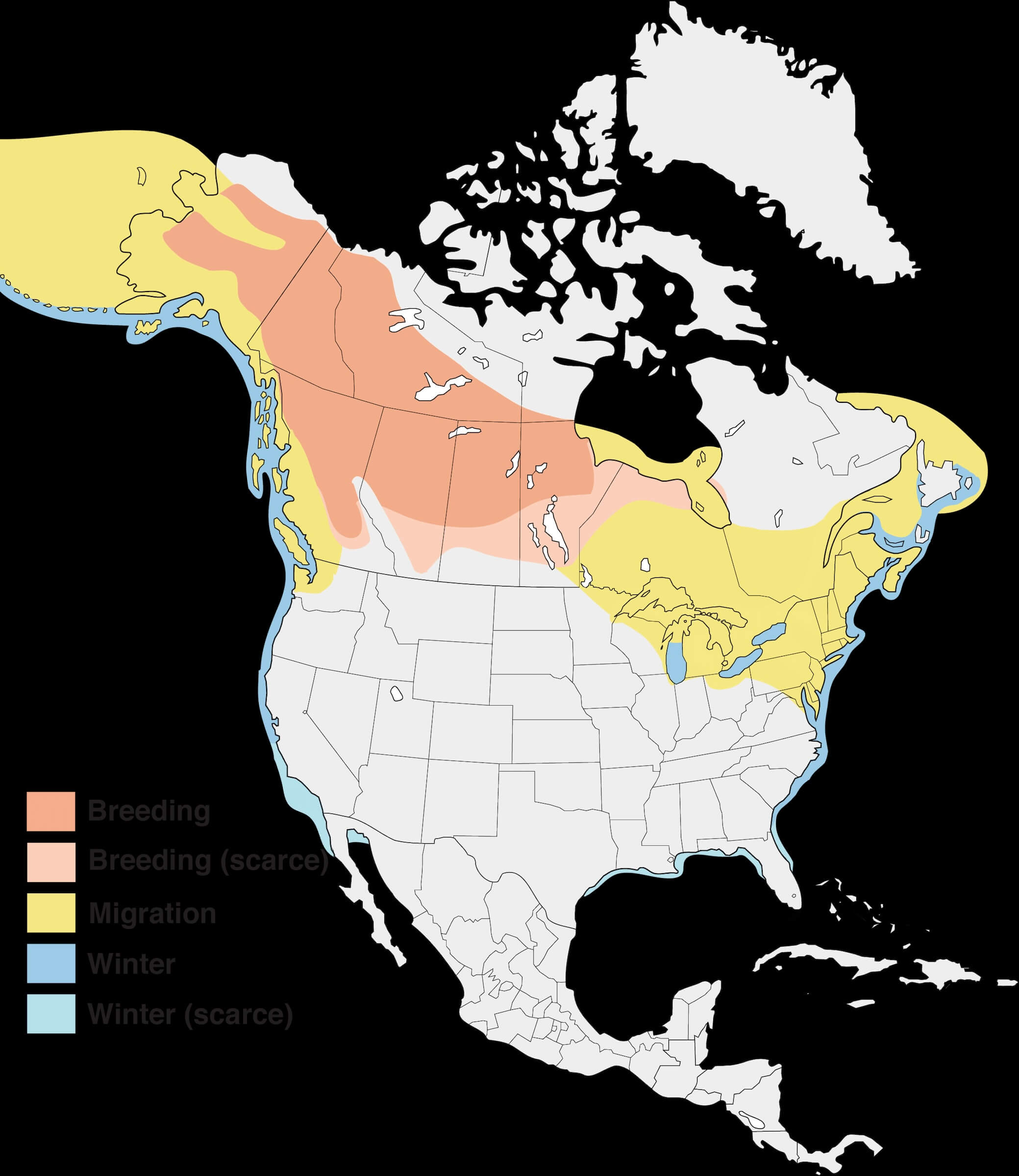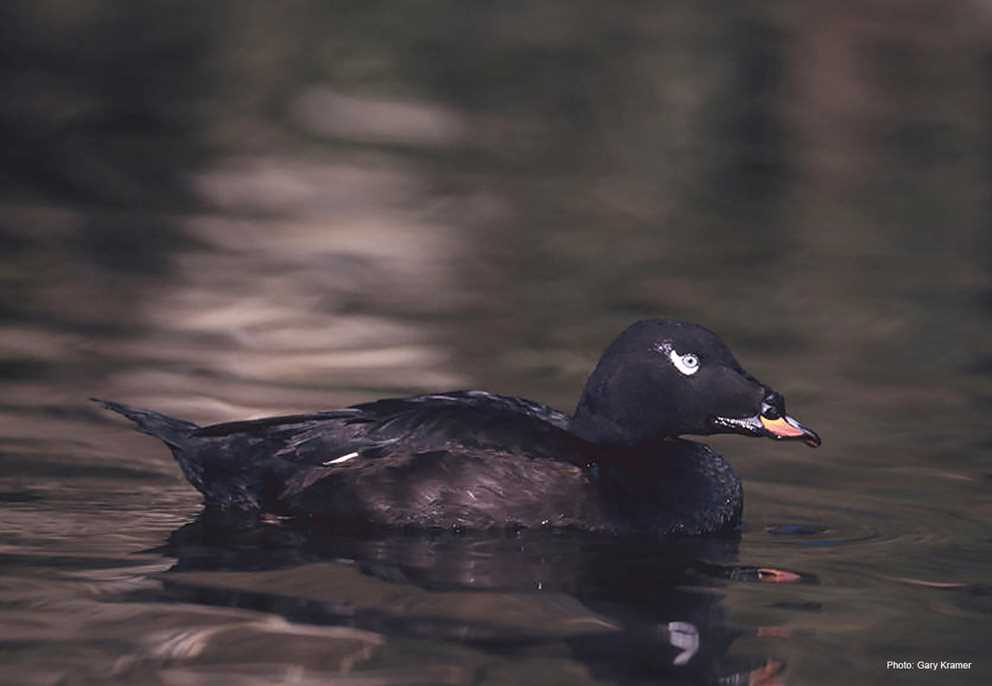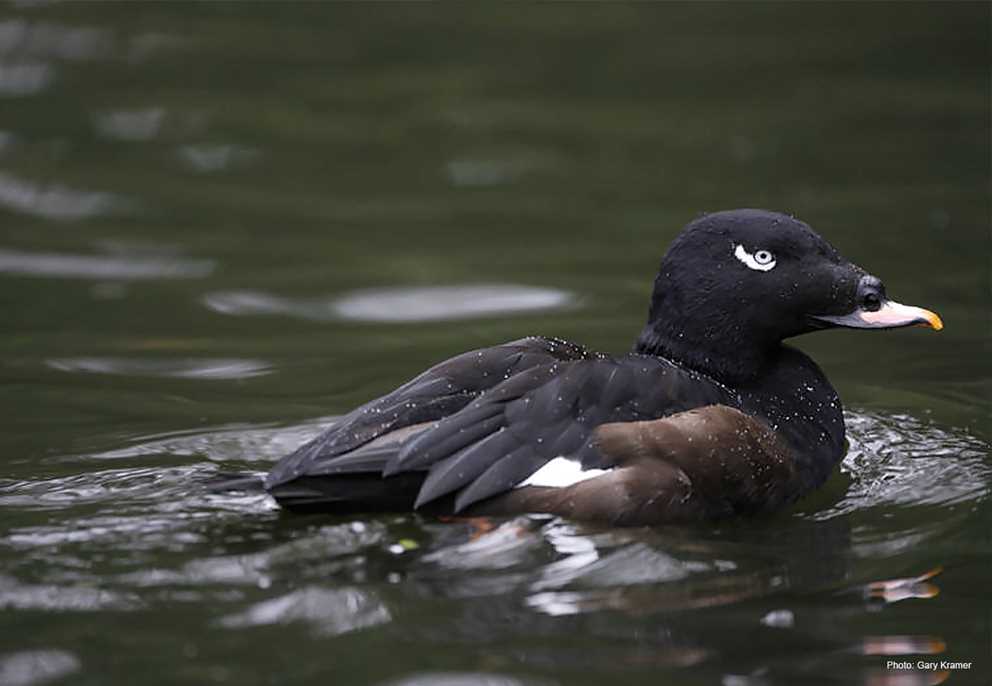Overview
White-winged Scoters are large sea ducks, and the largest of the three North American scoter species, with a range restricted to North America. Their breeding habitat is freshwater lakes and wetlands (occasionally brackish wetlands) of interior northwestern North America, from northern Manitoba to Alaska. In migration and winter, White-winged Scoters use nearshore marine habitats of the Pacific Coast from the Aleutian Islands to San Francisco Bay, with fewer found south to Baja. They also winter along the Atlantic Coast from Newfoundland and Labrador south to Georgia, with lesser numbers occurring south to Florida and the Gulf Coast. Some White-winged Scoters also winter in the Great Lakes.
Adult males are entirely black with a distinct white patch around the eye, an orange to red bill with a bulbous black knob at the base, and a bold white wing patch on the greater coverts and secondary wing feathers. Females and immature males appear uniformly brown with lighter brown bellies, with blackish bills lacking the large knob of adult males. The head shows white pre- and postorbital patches that are most distinct in immature birds and may not always be evident in adult females. Nests are associated with large boreal lakes and wetlands.
Description
Key Identification Features
- Male White-winged Scoters are black, the head shows a distinct smallish white marking below and behind the eye, and they show dark wing surfaces showing a diagnostic, highly visible white patch on the greater coverts and secondary feathers. The large bill which appears orange to red, has a bulbous black knob at the base.
- Females and immature males appear deep brown, have dark wing surfaces showing the diagnostic white wing patch on the greater covers and secondary feathers. Females and immature males show two indistinct white patches, below, and forward of the eye and behind the eye. The bill is grayish black.
Male/Female Average Length and Weight
- Weight: Males 3.0–4.7 lbs.; Females 2.1–4.3 lbs.
- Wingspan: Males 10.7–11.6 in.; Females 10.1–11.2 in.
Male Identification
- Alternate (Breeding) Plumage: Adult males are black, may appear faded with shades of brown, but this plumage is like the basic plumage. The bill coloring maybe subtle orange or red with a bulbous black knob at the base. They also have very visible white wing patches on the greater coverts and secondary feathers.
- Basic Plumage: Contour plumage is black and shows distinct white wing patches on greater coverts and secondary feathers. The bill is bright orange to reddish.
Female Identification
- Alternate (Breeding) Plumage: Like basic plumage with subtle differences not easily distinguishable.
- Basic Plumage: Deep brown to olive brown, head ranges from all dark, to presence of poorly defined light area on cheek near base of bill, and poorly defined white cheek patch (variable with molt stage).
In-flight Identification
- In flight they appear all black except for the white marking(s) on the face. On the wing the large white wing patch on the upper wing surface is obvious.
Vocalizations
- Males make a double whistle “whur-er” or “fee-er” call during the breeding season.
- Female alarm calls are a low “gutta, gutta, gutta” to alert brood of danger.
- Wings of all three scoters species make a strong whistling noise in flight.
Similar Species
- Remarkably similar to Velvet Scoter (M. fusca) of Europe, and Stejneger’s Scoter (M. stejnegeri) of western Eurasia, difficult to separate without scrutiny—range is a useful but not 100 percent reliable tool. Relative to Surf Scoters and Black Scoters, and the Eurasian Common Scoter (M. nigra), the White-winged Scoter is distinguished by the presence of the white patch on the greater covert and secondary wing feathers. Female White-winged Scoters are separated from female Surf Scoters by having a less flattened head profile and a heavier bill. White-winged Scoters are typically notably larger than Surf or Black Scoters.
Habitat Preferences
- Breeding: White-winged Scoters are typically found in freshwater (occasionally on brackish wetlands) boreal lakes and wetlands.
- Migration and Winter: White-winged Scoters use nearshore marine habitats of the Pacific Coast from the Aleutian Islands to San Francisco Bay, with fewer found south to Baja. They also winter along the Atlantic Coast from Newfoundland and Labrador south to Georgia, with lesser numbers occurring south to Florida and the Gulf Coast. Some White-winged Scoters also winter in the Great Lakes.
Foraging Habits and Diet
- White-winged Scoters forage extensively on invertebrates throughout the annual cycle. During spring and summer, they ingest amphipods, aquatic insects, and crustaceans, while in their wintering areas they consume a wide range of invertebrates, especially mollusks and crustaceans. In late winter or spring, western birds forage heavily on herring spawn.
Breeding Habits
- Monogamy: White-winged Scoters are considered monogamous, with new pair bonds formed variably in winter, spring migration, and breeding areas. The duration of pair bonds is unknown, but some observations suggest possible multiple-year durations.
- Nest Location: Nest is in association with boreal lakes and wetlands with nest sites 110–875 yards from water in dense, thorny cover.
- Clutch Size: 8 to 9 eggs. The eggs are elliptical, creamy buff to light pink, and are 2.7 by 1.8 in. The incubation period is approximately 25 to 30 days.
Migration and Distribution
- Fall Migration: White-winged Scoters are poorly studied with respect to migration, but they depart breeding wetlands in June–July (males, unsuccessful females) or July–August (successful females). Upon completion of wing molt, migration to winter areas begins in August. Arrival on migration and winter areas variable, beginning as early as September, peaking in October and November.
- Spring Migration: Spring migration may begin as early March or as late as May, with some birds lingering into June. Most birds arrive in boreal breeding areas in May.

Conservation Status
- IUCN Status: Least Concern
- Population Status: The global population estimate is not well understood but may be 500,000–800,000 birds. Data supporting estimates are poor and estimation difficult given range in the boreal taiga and coastal maritime areas. Limited data suggests that the populations have declined around 50% since the 1950s, but the cause(s) and rates of declines are poorly understood.
- Conservation Status: Habitat degradation primarily in their breeding areas through agricultural conversion has eliminated important nesting habitats. White-winged Scoters are also susceptible to exposure to environmental contaminations including oil spills.
- Conservation Focus: More research into their population status and conservation challenges is needed. Restoration and protection of nesting habitats and wintering habitats would be beneficial to the species.
Harvest Information
Harvest estimates are not readily available for Black, Surf, and White-winged Scoters separately. The following statistics are based on data from 1999 to 2008.
- An average of 8,527 White-winged Scoters were harvested per season across the US from 1999 to 2008.
- White-winged Scoter harvest is typically highest in the Atlantic Flyway, accounting for around 65 percent of the total US harvest.
- The top three states for White-winged Scoter harvest are New York, Massachusetts, and Maine.


